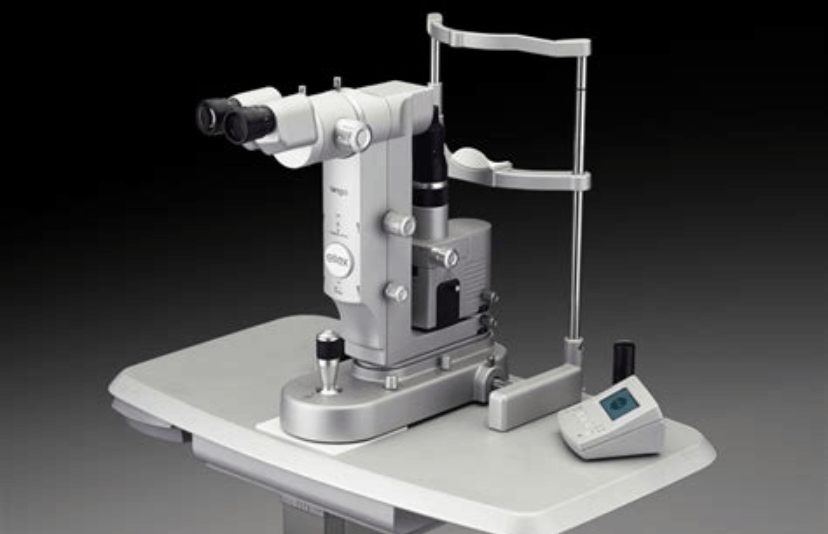Glaucoma
What is Glaucoma?
Glaucoma is a leading cause of blindness and visual impairment, affecting over 300 thousand people in the Canada or approximately one percent of the population. It can affect patients of all ages, many of whom do not experience any symptoms. In fact, over half of the people afflicted do not even realize they have it. Glaucoma refers to a group of diseases that have the final common pathway of causing damage to the optic nerve. The optic nerve functions much like a cable, connecting our eyes to our brains, relaying what we see. Damage from glaucoma, most frequently caused by elevated eye pressure, can lead to the development of blind spots in our visual field. Without routine eye exams to check the health of one’s eyes, these blind spots can go undetected and in the worst-case scenario can lead to total permanent blindness.
In the early stages, glaucoma does not have any noticeable symptoms and is commonly referred to as the "silent thief." Though a cure has yet to be developed, it’s progression can be slowed via early detection and appropriate treatments.
Get in touch
Glaucoma Form
Symptoms
Glaucoma often causes no pain or other noticeable symptoms until the disease has progressed significantly. Later stages of the disease may cause a gradual loss of peripheral vision, as well as eye pain, blurred vision, nausea, vomiting, halos around lights and other troubling symptoms. The type and severity of symptoms depend on the type of glaucoma and the patient's eye and overall health.
Risk Factors
Glaucoma can affect both newborns and the elderly and anyone in between. Those who are at an increased risk for developing glaucoma are those who:
- Are 45 years of age
- Do not attain regular eye exams
- Have a family history of the condition
- Experience abnormally high eye pressure
- Have preexisting health conditions, such as Diabetes
- Are nearsighted
- Have experienced some form of eye trauma
- Have taken corticosteroids for extended periods of time
Causes
Glaucomatous optic nerve damage occurs, in most cases, from elevated eye pressure. The eye itself, much like a ball, is a closed system. In the eye, a fluid called the aqueous humor is produced by a gland called the ciliary body. This fluid flows throughout the eye, delivering nutrients to its different parts. The fluid then drains out of the eye through a complex tissue called the trabecular meshwork. Elevated ocular pressure can come about if there is an imbalance between how much fluid is produced or how much fluid is being drained. This elevated pressure can then damage the optic nerve leading to glaucomatous damage. Many different ocular disorders can lead to elevated pressure. Nearly any eye disorder associated with aging, inflammation, bleeding, injury, tumors, or even birth defects can raise eye pressure.
Diagnosis
Glaucomatous optic nerve damage occurs, in most cases, from elevated eye pressure. The eye itself, much like a ball, is a closed system. In the eye, a fluid called the aqueous humor is produced by a gland called the ciliary body. This fluid flows throughout the eye, delivering nutrients to its different parts. The fluid then drains out of the eye through a complex tissue called the trabecular meshwork. Elevated ocular pressure can come about if there is an imbalance between how much fluid is produced or how much fluid is being drained. This elevated pressure can then damage the optic nerve leading to glaucomatous damage. Many different ocular disorders can lead to elevated pressure. Nearly any eye disorder associated with aging, inflammation, bleeding, injury, tumors, or even birth defects can raise eye pressure.
Types of Glaucoma
Glaucoma Management Options
Once a diagnosis of glaucoma is made, there are numerous approaches available to successfully manage the condition. All of these methods focus on reducing internal eye pressure to stop more injury to the optical nerve. A great number of people who are in the first stages of the disease are often able to delay or stop their vision loss by managing glaucoma with prescription eye drops.
For patients whose condition is more severe, we use various treatments, including MIGS (minimally invasive glaucoma surgery), laser therapies, and trabeculectomies, that may ease the condition significantly.
Take Control of Glaucoma
At Visionary Eye Surgeons, we frequently meet with individuals dealing with glaucoma to assist them in managing the disease. It’s critical to know that getting a diagnosis and treatment in the early stages can help you keep your symptoms under control. We urge everyone who has these symptoms, who has a genetic predisposition or who has a current diagnosis to plan a consultation at our office.
About Glaucoma Laser Treatment
Our Ophthalmolgists at Visionary Eye Surgeons provide several laser treatments that help control glaucoma. Using the advanced Selective Laser Trabeculoplasty (SLT) and laser peripheral iridotomy (LPI) technology, our surgeons can use various treatments that work best for your type of glaucoma.
Who Needs Laser Treatment?
At Visionary Eye Surgeons, we recognize that each patient is unique, requiring an individualized treatment plan. Based on your type of glaucoma and the severity of your condition, we will assess what laser type or technique works best for you. Over the past decade, laser treatments have moved to the forefront in combating glaucoma. In some patients, laser treatments are recommended to help supplement a medication regimen. In other patients, laser treatments may be recommended as first-line therapy.
Specific lasers treat different parts of your eye to help with various conditions. To identify which laser treatment is best for you, our ophthalmologists will complete a series of diagnostic tests and a comprehensive eye exam. We can detect these issues in regular appointments so it is important to undergo comprehensive eye exams each year. Additionally, if you have received a glaucoma diagnosis, we will start treatment as soon as possible to prevent any further symptoms.
How is Laser Treatment Done?
At Visionary Eye Surgeons, our expert ophthalmologists use state-of-the-art laser technology to treat different glaucoma types. We can complete innovative laser treatments that work best for your condition, including:
Follow-Up
Following your laser glaucoma treatment, our physicians will monitor you to ensure no irregularities arise. Before you leave, our team will schedule future follow-up visits. It is very important to attend these appointments so we can make sure your eye(s) is healing correctly. Additionally, if you start to notice any severe eye pain or inflammation, please call us as soon as possible.


